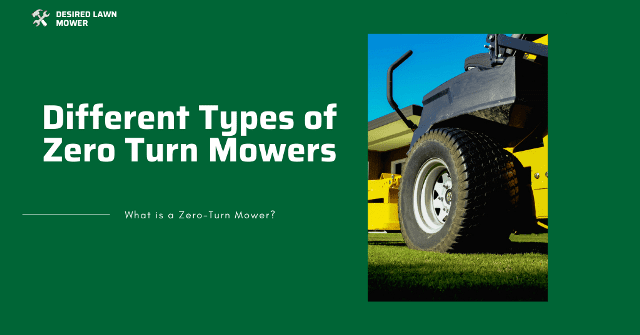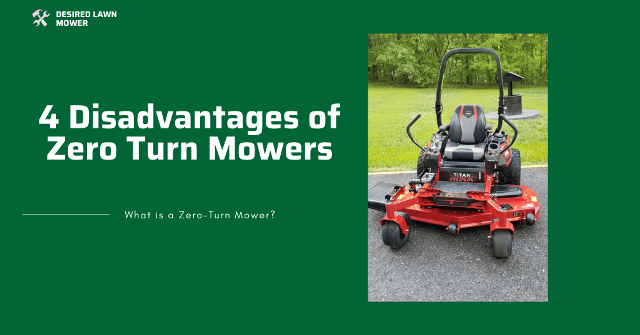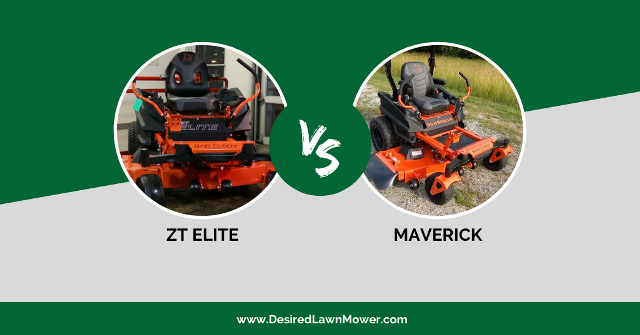The first time I heard the term “zero-turn mower” I imagined a lawn machine that couldn’t take turns and I wondered why on earth anyone would want such a burden– how distinctively wrong I was!
A Zero-turn mower is a kind of lawn machine that has a turning radius of zero degrees. In simpler terms, the mower can rotate on a spot.
You can compare zero-turns to lawn tractors; when tractors get to the end of the line, they go back and forth to make a turn. Whereas zero-turn mowers stand firm on their rear tires while the rest front tires make a grand semi-circle (or a full circle) turning the whole machine around.
The major gimmick is all on the front caster wheels; these tires are affixed in a way that allows them to make point zero turns when both tires face opposite directions. Just like cars, zero-turn mowers can also make flexible turns.
Typically, a z-turn mower has four wheels; the drive wheels and caster wheels with a deck sandwiched between them. You can either stand or sit on the mower as you operate the joystick, wheel, or levers. We’ll get into all that in detail starting from how zero-turn mowers came to be.
How Did Zero-Turn Mowers Come About?
There’s been a ruckus on who invented the machine; the first record of a zero-turn mower wasn’t officially a market sale, so some cranky heads claimed it didn’t occur as the first recorded zero-turn.
- Max Swisher, 1949
Max Swisher hated mowing grass! One day, he tied one end of a rope to a self-propelled mower he made, and the other end of the rope to a tree. The mower propelled itself around the tree, shortening the rope as it went by, and cutting the grass in perfect circles while Max sat and watched in pride.
It didn’t take long for him to spice up his idea by creating the first-ever zero-turn mower in 1949. It was a strange machine; it had one crazy tire in front, two at the rear, and a steering wheel that would turn 360 degrees causing the single front tire to spin the mower on a dot! He named it “the Ride King.”
- John Reiger, 1963
The second record of the mower hit the market and got registered as the first-ever invention of a zero-turn, but it wasn’t exactly the first record of the machine since it came after the “unregistered” zero-turn.
John Reiger was blown away by a swather that was freshly manufactured at his workplace Hesston Corporation. The belt and pulley mechanism swept him off his feet, and he immediately wondered what counter-rotation – an attribute of a pulley system – would become on a riding mower.
After many knick-knacks, in 1963 Reiger managed to invent a zero-turn lawn mower with four tires- where the two front tires are individually controlled by two teaming levers, causing the mower to turn on a dime. The problem was they had a lever instead of the ‘normal’ steering wheel! People started to wonder what to make of this quirky-looking machine, and skeptics simply refused to engage them. Thankfully for Reiger, Hustler Turf and BigDog Mower Corporations took interest in his invention, and now the Hustler is a common zero-turn brand today!
There Are Different Types of Zero-Turn Mowers

Of course, inventions of zero-turns didn’t just end with Swisher or Reiger. There are a few ways to classify the different versions of the machines. Here’s how you can classify Zero-Turn Mowers:
Based on The Method of Steering
- The Double Levered Zero-Turn Mowers
This kind of z-turn is the basic description of the machine; two levers sticking out of the seating area like antennas – a lever to a front wheel – that would cause the machine to pivot on its spot. You do this by pulling one lever towards you and the other lever away from you to complete a circle. On a scale of 1 – 10, I give these machines a 6 on the learning curve. They’re not so easy to get around on the first day, but when you get a hang of them, it’s just you and the breeze!
- Joystick Zero-Turn Mowers
Instead of the two antennas, you get one lever at the center, or for very modern zero-turn mowers, at the side of the machine. This mower is much easier to learn; all you have to do is swipe far left or far right to make a 360-degree turn. I give them a 7 on a scale of 1 – 10 on the learning curve.
- Steering Wheeled Zero-Turn Mowers
As the name implies, they have wheels! If getting out of your comfort zone is rather too uneasy for you, the wheels are just your best bet. Since most of our riding lawn machines have wheels, it wouldn’t be so difficult to transition to a wheeled zero-turn mower at all. All you have to do is rotate the wheel at a complete 360 degrees to make the spin. On a scale of 1 – 10 on a learning curve, I give these mowers a 9!
Based On How They’re Powered
- Gas-Powered Zero-Turn Mowers
These Z-Turns are easily the most popular kinds that exist. They are powered by petroleum and carry a whole lot of other systems to back up the power source; you have the transmission system, the hydraulic system, choke, engines, and all the regular-maintenance parts of the engine. They are the most reliable and toughest bet, but they’ve had quite the competition with their rivals, the electric mowers. The only downside to this kind of power is the pollution, heck of a noise, and never-ending prep maintenance.
- Battery-Powered Zero-Turn Mowers
Also known as the electric zero-turn mowers. These kinds of lawn machines are only newbies in comparison to the gas-powered ones. They run on rechargeable batteries in comparison and offer a noiseless, smokeless mow. They’re also much lighter and compact to deal with. Battery-powered zero-turn mowers are also notably less expensive in comparison to gas-powered ones.
Based On How They’re Used
- Riding Zero-Turn Mowers
As read, you hop on them, have a seat, and ride through the plains of your lawn. These are also the most popular means of using the mower; the seating is one of the most crucial parts of a z-turn. If you spend hours upon hours mowing, the least you’d want to be is comfortable enough to deliver an effective job.
- Stand-On Zero-Turn Mowers
With this kind of mower, you stand on a platform at the rear wheels of the mower like you’re addressing a crowd, with the controls in front of you to maneuver the machine. Further ahead are the deck and front caster wheels. The stand-on mowers are fairly good for hillsides; they are compact and lightweight in comparison to the sitting zero-turns, although they’re simply not as safe as you’d be highly exposed to accidents. Also, it’s bad news for your knees if you’re handling more than 2 acres.
- Walk-Behind Zero-Turn Mowers
In a big contrast to sitting or standing, you’d have to walk behind this zero-turn as you mow the lawn. There’s obviously more back and feet-straining work on these types. Best to avoid the walk-behinds if you have more than an acre and half.
Why Should I Get A Zero-Turn Mower?
- They’re highly maneuverable
This point is a key factor for all zero-turn mowers; mowing through trees and garden roundabouts isn’t a speck of a problem for the zero-turn mowers. Grab onto your levers or wheels and steer your way to a time-saving and stressless experience!
- They Save Time Tremendously
With lawn tractors, at the end of each line, you’d have to do a little pendulum-like movement to shimmy onto a new track. You can save all that time with one swerve on the zero-turn mower carving a pretty stripe as you go.
- They Deliver A Much Neater Cut
If you’re a big fan of stripes, the zero-turn mower will please you tremendously. Gone are uneven cuts and patterns at the edges and nooks of your yard. With an easy swerve, you can swing through all circumstances without scalping or ruining the stripes.
What Are The Disadvantages of Zero-Turn Mowers?

- They Come With a Steep Learning Curve
Imagine trying to understand the mechanism of two levers that seem to poke at your eyes when all you’ve ever used to maneuver a machine is a wheel– it would be quite the sight for you! Especially when there are risks of getting hurt, you’d want to tread as carefully as you can and that is why the levered zero-turns have a steep learning curve.
- Compared To Lawn Tractors, Zero-Turns Fare Poorly on Hills
Zero-turn mowers will do their best on flat terrain, but I can’t say the same for hills. The almost uneven division of weight on the machine puts them down the chart a little. Hills over 15 degrees are a total danger zone and wet terrain could cause the machine to topple over. Although at present time, there are specific models that offer good traction for such scenarios- they still are not the best lawn machines for hills.
- They Are Quite Pricey
Isn’t this expected? Zero-turn mowers are quite pricey on many terms. Not only do you pay through your teeth for a good class – the high-grade residential models – you also pay enough for maintenance. It’s a signature thing, honestly; zero-turn mowers come with heavy price tags!
- Front Caster Wheel Problems
The smaller wheels in the front of the mower are built for maneuverability, but they don’t quite fare well in resistance to harsh scenarios. They could either get stuck in puddles due to their smaller sizes or get dented at the casters when you hit an obstacle. You won’t find any front caster wheel problems on the lawn tractors because all the tires are fully shielded and are of the same size.
Are Zero-Turn Mowers Better Than Lawn Tractors?
Well, it depends on who’s lawn the answer is referring to. Lawn tractors have their pros and cons, as zero-turn mowers do. However, they do slash the lawn tractor’s mowing time by half and are easier to work with in garden-like lawns with sprouts of all shapes of plants here and there, including obstacles that your lawn tractor will definitely hate to work around. Check out the Lawn Tractor vs Zero-Turn Mower comparison to see which one is best for you.
The Verdict
Zero-turn mowers have been in the game for so long, and have been heroes for lots of lawn tenders who mow over 2 acres of yard. In fact, zero-turns are overthrowing the spots of regular lawn tractors and walk-behind mowers. Who wouldn’t want a highly maneuverable ride that lets them spend more time doing stuff they actually love on a sunny afternoon? I highly recommend a zero-turn mower; they make the work faster and easier to do. The downsides are considerable, but for what it’s worth, a zero-turn mower is very much worth it if you ask me.
